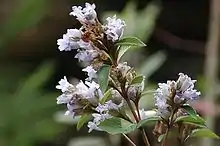Kurinjimala Sanctuary
Kurinjimala Sanctuary protects the approximately 32 hectare core habitat of the endangered Neelakurinji plant in Kottakamboor and Vattavada villages in Devikulam Taluk, Idukki district of Kerala state, South India.[1][2]
History
According to some historians, the earliest known inhabitants in South India were hunter-gatherers and earliest inhabited region was Kurinjimala.[3]
The sanctuary was declared by the Kerala Forest Minister Benoy Viswam at the Neelakurinji Fest at Munnar on 7 October 2006. During the 2006 bloom, massive flowering of Neelakurinji attracted nearly ten lakh (1,000,000) people to Munnar and other places.[4]
The Government notification said that the sanctuary would ensure the long-term protection of the unique biodiversity of the area, especially Strobilanthes kunthiana and its habitat. Private land holdings having legal titles are excluded from the sanctuary area.
Wildlife
The sanctuary is home to threatened species of elephant, Gaur, Nilgiri tahr and deer.
The new sanctuary is contiguous to the Chinnar Wildlife Sanctuary to the northwest, Manjampatti Valley in Amaravati reserve forest of Indira Gandhi Wildlife Sanctuary to the northeast, Eravikulam National Park and Anamudi Shola National Park to the west, Pampadum Shola National Park to the south and the proposed Palani Hills National Park to the east. The sanctuary provides continuity and connectivity to these five protected areas.[5][6]
Silambam
The ancient martial art of Silambam known to be practiced by the Tamil people originated at Kurinji hills. It derives from the Tamil word silam, meaning hill and the Kannada word bamboo from which the English bamboo originates. The term silambambu referred to a particular type of bamboo from the Kurinjimala.[7] Silambam staff is known as neduvadi in Kerala, dhanta varisai in Karnataka, and karra saamu in Andhra Pradesh.[8] Currently three types of Silambam are practiced: Porsilambam (warfare), Silambattam (folk dance), and Potti Silambam (sport).[9]
References
- "Kurinjimala Sanctuary" (PDF). forest.kerala.gov.in. Retrieved 27 November 2020.
- http://kurinji.in/kurinjimap.html
- Rajagopalan, Krishnaswamy. A Brief History of Physical Education in India (New Edition). Google Books. ISBN 978-1-4918-8722-6. Retrieved 5 December 2020.
- Mathew Roy (7 May 2007) "Neelakurinji - generation next" the Hindu, retrieved 5/12/2007 the Hindu Archived 1 October 2007 at the Wayback Machine
- Government of Kerala, Forest and Wildlife Department, Notification No. 36/2006 F&WLD (6 October 2006) retrieved 5/12/2007 Kerala Gazette Archived 30 December 2007 at the Wayback Machine
- Mathew Roy (25 September 2006) "Proposal for Kurinjimala sanctuary awaits Cabinet nod", retrieved 5/12/2007 The Hindu Archived 1 October 2007 at the Wayback Machine
- "Martial Arts (Silambam & Kalaripayattu)". fitindia.gov.in. Retrieved 27 November 2020.
- Experts, Arihant. Indian Art & Culture. Arihant Publications India limited. ISBN 978-93-5094-484-4. Retrieved 5 December 2020.
- Ramaswamy, Vijaya. Historical Dictionary of the Tamils. Rowman & Littlefield. ISBN 978-1-5381-0686-0. Retrieved 5 December 2020.
